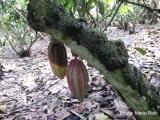Disease
The primary forest disease caused by P. palmivora is black pod disease of cacao. The first published reports on cacao were in 1909 by Von Faber and by Maublanc, who described the causal pathogen as a new species, Phytophthora faberi (Ashby, 1929). In 1924, Butler reported that P. faberi and P. palmivora were the same species, so the earlier name, P. palmivora, took precedence. The primary impact of this disease is on the cacao pods (fruits), eventually infecting the beans within the pods rendering them of no commercial value. The disease is known throughout the world wherever cacao is grown. In Central and West Africa, P. palmivora is known to exist in the same areas with P. megakarya, and both species can cause black pod disease. P. palmivora is also known to have serious effects on other hosts such as citrus (canker, fruit rot, and root rot), coconut (bud rot and fruit rot), papaya (stem rot and root rot), black pepper (root rot and collar rot), and durian (canker, root rot, leaf blight, and fruit rot). Inoculum is spread through rain splash, wind, insects, and human activity.
Although P. palmivora has a wide host range of over a thousand plant species, including ornamental plants as well as horticultural and agricultural crops, the only major concern in a forest setting appears to be on cacao. P. palmivora is believed to be responsible for annual losses of 20-30% of the world’s cacao crop (Erwin and Ribeiro, 1996). The isolation of P. palmivora from noncultivated forest soil in Ghana indicates that this species is indigenous to forest soils (Kakwa, 1974). Most other economically important hosts such as citrus, coconut, papaya, black pepper, and rubber are in closely managed agricultural settings, sometimes in close proximity to natural forests. In 1993, Bernard and Mitchell reported P. palmivora on red maple (Acer rubrum) for the first time in the U.S. However, no reports on the actual impact of this species on hardwood trees have been found to date.
On cacao, P. palmivora primarily causes a pod rot (black pod) but is also known to cause stem cankers and seedling blight. Black pod can be caused by either P. palmivora or P. megakarya. In Asia, Central America, and South America, the disease is caused by P. palmivora. In Central and West Africa, both species occur and either may cause black pod. Symptoms caused by P. megakarya and P. palmivora can be distinguished in the field because P. megakarya produces lesions with irregular edges on the fruit whereas lesions caused by P. palmivora have regular borders and are generally smaller (Erwin and Ribeiro, 1996). Pods are susceptible at all stages of development and may be infected at any place on the surface. The first symptom is a brown to black spot on the pod, which spreads rapidly in all directions and eventually covers the whole pod. The beans become infected internally about 15 days after the initial infection and are soon of no commercial value. Several other forest species are known to become infected and to maintain the pathogen at low levels but the impact on black pod disease itself is not fully understood.
P. palmivora also causes bud rot and fruit rot of coconut in wildland and agricultural settings. On other hosts, P. palmivora causes a range of symptoms such as root rot, cankers, and leaf blight. Economically important agricultural crops include durian, citrus, rubber, mango, black pepper, and papaya.
| Host Latin Name | Host Common Name | Symptoms | Habitat | Region | |
|---|---|---|---|---|---|
| Acacia mangium | Brown salwood | Canker | Forest | Indonesia | |
| Acer rubrum | Red maple | Canker, Root rot | Forest | Canada, USA | |
| Artocarpus altilis | Breadfruit | Blight, Fruit rot | Forest | American Samoa, India | |
| Borassus flabellifer | Palmyra palm | Bud rot | Agricultural setting, Forest | India | |
| Carica papaya | Papaya, Pawpaw | Canker, Fruit rot, Root rot | Agricultural setting | American Samoa, Australia, Brazil, Hawaii, Mexico, Spain, Sri Lanka, Taiwan | |
| Citrus spp. | Citrus | Collar rot, Fruit rot, Root rot | Agricultural setting | India, Japan, USA - Florida | |
| Cocos nucifera | Coconut palm | Bud rot, Fruit rot | Agricultural setting | India, Indonesia, Jamaica, Pacific Islands, Philippines, USA - Florida | |
| Durio spp. | Durian | Fruit rot, Leaf necrosis, Root rot | Agricultural setting | Australia, Indonesia, Malaysia, Thailand | |
| Hevea brasiliensis | Rubber | Canker, Dieback, Leaf necrosis | Agricultural setting | Brazil, China, Côte d’Ivoire, India, Malaysia, Nigeria, Philippines, Sri Lanka, Thailand, Vietnam | |
| Mangifera indica | Mango | Canker, Collar rot, Root rot, Seedling disease | Agricultural setting | India, Philippines | |
| Piper nigrum | Black pepper | Collar rot, Root rot | Agricultural setting | Asia - SE, Caribbean, Pacific Islands, South America | |
| Theobroma cacao | Cacao | Canker, Fruit rot | Forest | Brazil, Cameroon, Costa Rica, Nigeria, Puerto Rico, Sri Lanka, Vietnam |



